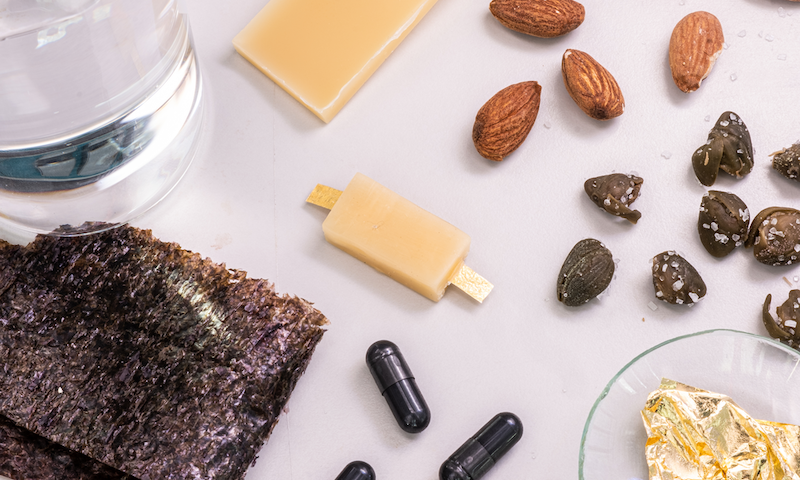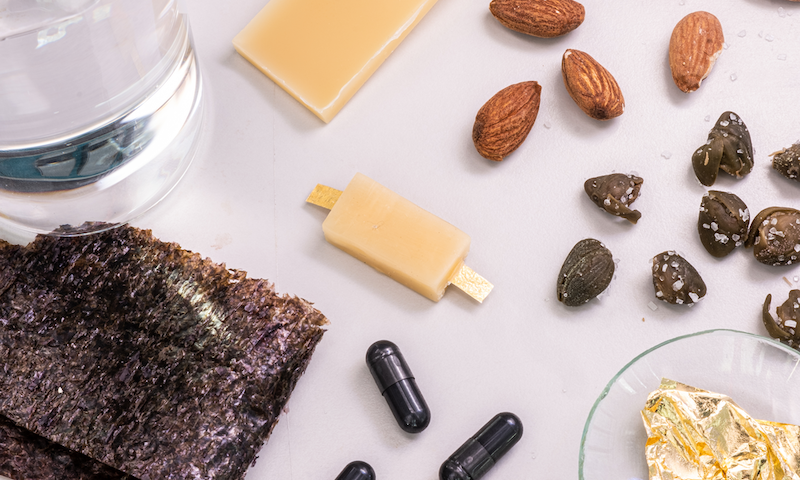Today’s Chef’s Special: A Rechargeable Battery
An estimated 3 billion batteries are thrown away in the US each year. Most of those batteries end up in landfills, where they leak their toxic materials into the environment. Now Mario Caironi at the Italian Institute of Technology and colleagues have created a safe and green alternative, demonstrating the first edible, rechargeable battery [1]. The team says that the battery, which is made of food-derived materials, could power tools used to diagnose and treat gastrointestinal tract diseases and to monitor food quality.
Creating edible electronics—fully digestible devices made of biodegradable components—is a growing enterprise. While ingestible devices, such as pills containing cameras or digital systems, are already used in healthcare, those devices currently contain inedible components that need to be retrieved after use.
One of the most significant challenges in creating a fully edible electronic system is designing a power source that is safe to eat and that has the needed power-generation properties. Currently, most ingestible technologies fail this requirement. “There is a limited selection of food-grade chemicals with the right electric properties to build a battery,” Caironi says.
One edible material that does have the right electrical properties is riboflavin (RF), a vitamin found in almonds. Another is quercetin (Q), an antioxidant plant pigment found in berries, capers, and citrus fruits. Caironi and his team used both these materials in their battery. They also used activated charcoal (AC), a digestible material that is typically made from bamboo or from coconut shell; nori algae, which is found in most sushi; beeswax; and gold foil, the same kind used to decorate baked goods.
The team’s battery has a sandwich-like structure consisting of two gold-laminated cellulose films separated by a layer of seaweed that has been soaked in salt water. The gold-cellulose films are each partially coated with AC into which either RF or Q has been mixed. This structure is wrapped in beeswax, with uncoated ends of the gold-cellulose films poking out on either side. The RF–AC and Q–AC layers of the battery act as the anode and cathode; the salt water as the electrolyte; and the gold as the current collector. The seaweed electrically isolates the anode and cathode from each other while the beeswax acts as the battery packaging.
The team tested the battery’s properties by connecting the battery to different heating elements—a standard testing method for evaluating the performance of batteries. The test showed that the RF–AC and Q–AC layers generated a stable current. The team also checked the recharging capacity of the battery, cycling it through tens of charging–discharging cycles, finding that it retained its needed performance for more than 50 cycles. They found that at 0.65 V, a voltage that can power an edible device without damaging the body, the battery sustained a current of 48 µA for 12 minutes. Finally, the team showed that two batteries connected in series were powerful enough to light a low-power LED or run a small sensor.
The demonstration shows that rechargeable batteries can be made solely from edible materials, says Conor Boland, a physicist at the University of Sussex, UK, who develops battery technologies. He notes that most of the research on developing new power sources focuses on making them smaller rather than safer or greener. “When producing new technologies, we need to think more broadly about how [those technologies] impact the planet,” which is what Caironi’s team does here, he says. Christopher Bettinger, a biomedical engineer at Carnegie Mellon University in Pennsylvania, agrees. He notes that most of the currently available edible devices contain at least some materials that have potential health risks to patients. “This work describes another step in developing application-specific materials for use in ingestible devices that could improve the safety and utility of this class of medical devices,” he says.
–Anna Napolitano
Anna Napolitano is a freelance science journalist based in London, UK.
References
- I. K. Ilic et al., “An edible rechargeable battery,” Adv. Mater. (2023).





